Grandma was very frugal, and I recall one year asking her why she saved everything. She told me that everything should be repurposed on the homestead.
Grandma had an entire shelf in the root cellar that was full of reusable containers and other things. One thing that grandma never threw away was sawdust.
The fact that grandma saved sawdust never occurred to me to be strange or odd because grandpa had a small sawmill, however, in retrospect, if grandpa hadn’t had a sawmill I have to wonder if grandma would’ve had uses for sawdust on their homestead.
I like to think she would have because it’s actually very versatile.
Sawdust was used in and around grandma’s homestead in a variety of ways. Since my grandfather had a small sawmill, we always had plenty of.
Whether you have a small sawmill, a wood shop, or simply cut firewood, you’re going to have no shortage of sawdust. If you don’t have any of the above, we’ve mentioned a few other ways to get your sawdust below.
Grandma had a variety of ways that we were required to help out on the homestead, one of these was to sweep the sawdust up and store it in a large barrel.
Of course, this could be a fun chore, or, if we’d been particularly ornery on any given day, it may be incorporated into our punishment.
What’s Sawdust Good For, Anyway?
There are plenty of ways to use sawdust, from keeping weeds and slugs away from your plants to creating a pathway to soaking up spills, and even starting a fire! You can also use it in the chicken coop or barn as bedding or even to insulate walls.
Here are some more great ways to use sawdust in and around your homestead…
Garden
There are many great uses for sawdust in and around the garden. Whether you’re using it to mulch plants or repel weeds you can find a myriad of uses for it. Keep in mind that you’ll need to reapply it periodically, especially if it rains.
- Use sawdust in and around plants to help repel weeds.
- Use sawdust on the pathway between plants.
- Use sawdust to deter slugs.
- Mulch with sawdust.
- Grow potatoes in sawdust.
- Store root crops in a bucket that has sawdust in it.
- Build a scarecrow and stuff it with sawdust.
- Grow mushrooms in sawdust.
- Amend the garden soil.
- Mix with your compost.
- Design your garden pathways with sawdust and add more to them as it breaks down and decomposes.
- Feed plants.
I’m constantly finding new uses for sawdust in our garden area. I keep a few buckets of the sawdust on hand near the garden and refresh it on our garden path frequently.
Winterizing
Winterizing on the homestead can be challenging. Adding sawdust to your winterization on the homestead can help make it easier.
We’ve discovered a few unique ways to use sawdust around our homestead during the harsher winter months. It really helps and it keeps our sawdust in rotation.
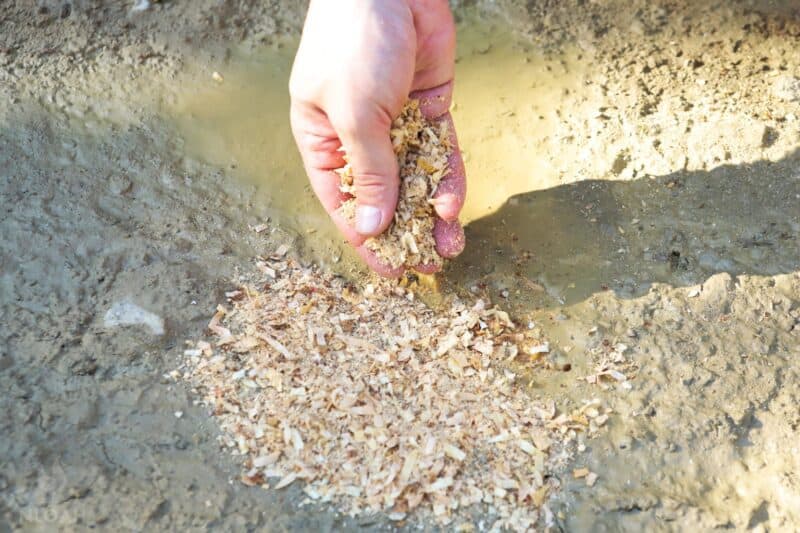
- Sprinkle sawdust on ice to help avoid falls.
- Sprinkle sawdust on mud to help absorb liquid and prevent muddy feet.
- Use in areas where puddles form.
- Keep a bag in the car during winter months to help offer traction if you’re stuck.
Winter lends many great uses for sawdust to my list. It’s perfect to keep an old coffee container full of sawdust to sprinkle over ice when it freezes and it really works well to sop up water when the ice begins to melt and puddles form.
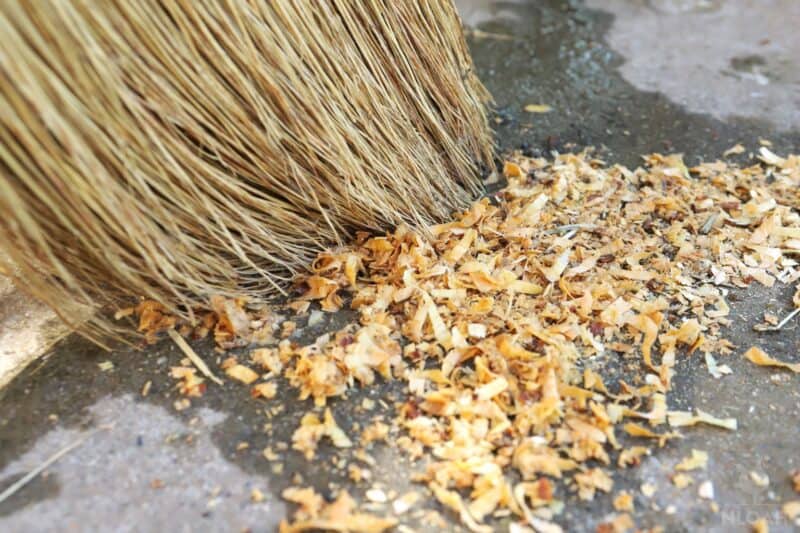
Barn / Shop Area
There are many great uses for sawdust in and around the barn. Keep a few five-gallon buckets of sawdust on hand in the barn for emergencies. Here are a few specific uses:
- Sprinkle on floors to help absorb moisture.
- Aid in cleaning up wet areas by sprinkling on the floor and then sweeping up.
- Help to absorb moisture in stalls and aid in clean up.
- Animal bedding.
- Use it on the bottom of the chicken coop.
- Use in the rabbit pen.
- Cat litter.
- Mop up spills.
- Absorb fluids after butchering.
- If you’re making a project save some in a small container in case you need to make repairs. Be sure to label the container with the exact type of sawdust wood and the name of the project.
We had to start covering our sawdust in the barn area because the barn kittens found it and thought that it made a great place to play and then use it as their litter box.
Now I just keep smaller-sized buckets with a lid on them in the barn area and if I need more I’ll haul it in with a wheelbarrow to avoid the barn kittens using it all as their potty.
In And Around The Homestead
There are many great reasons to keep the sawdust around on the homestead. You can find a variety of easy reasons to keep a few five-gallon buckets on hand.
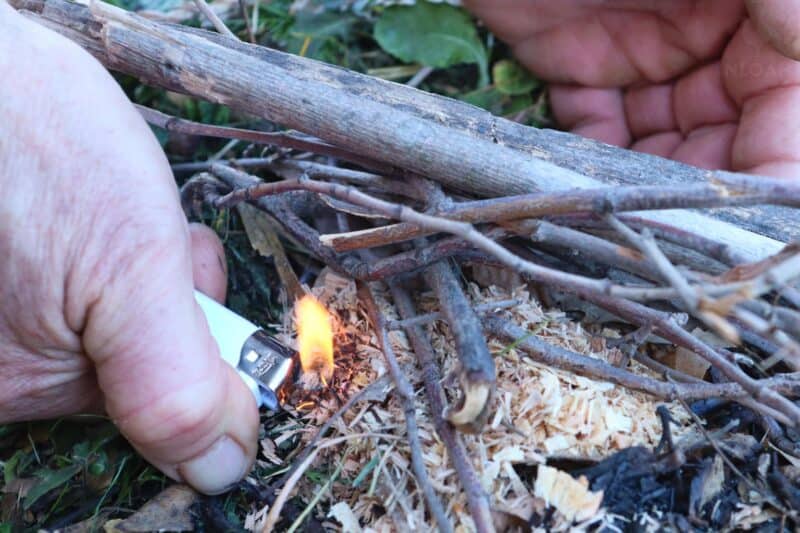
It’s quick and easy to use and you won’t have to struggle as much for some of your homestead chores when you add sawdust. Here are a few to get you started:
- Use as a fire starter.
- Make your own presto logs.
- Make your own fire bricks.
- Make your own smoker pellets.
- Make your own wood filler by mixing it with some glue.
- Many people used to use sawdust for insulation in walls.
- Pour sawdust into cupcake liners and melt some old candle wax over them for fire starters.
- Create sawdust burners to help keep warm.
- Make into a “candle” using a tin can and some wax.
- Use underneath of straw or hay to help absorb moisture.
- Mix with moisture to make a mortar for chinking a cabin or for making bricks.
- Use as mulch around trees on the homestead.
- Mix it with clay or mud to create a facial (note: make sure the sawdust is a very fine dust for this to avoid any splinters).
- Make a pincushion with it and use it to help keep needles and pins sharp.
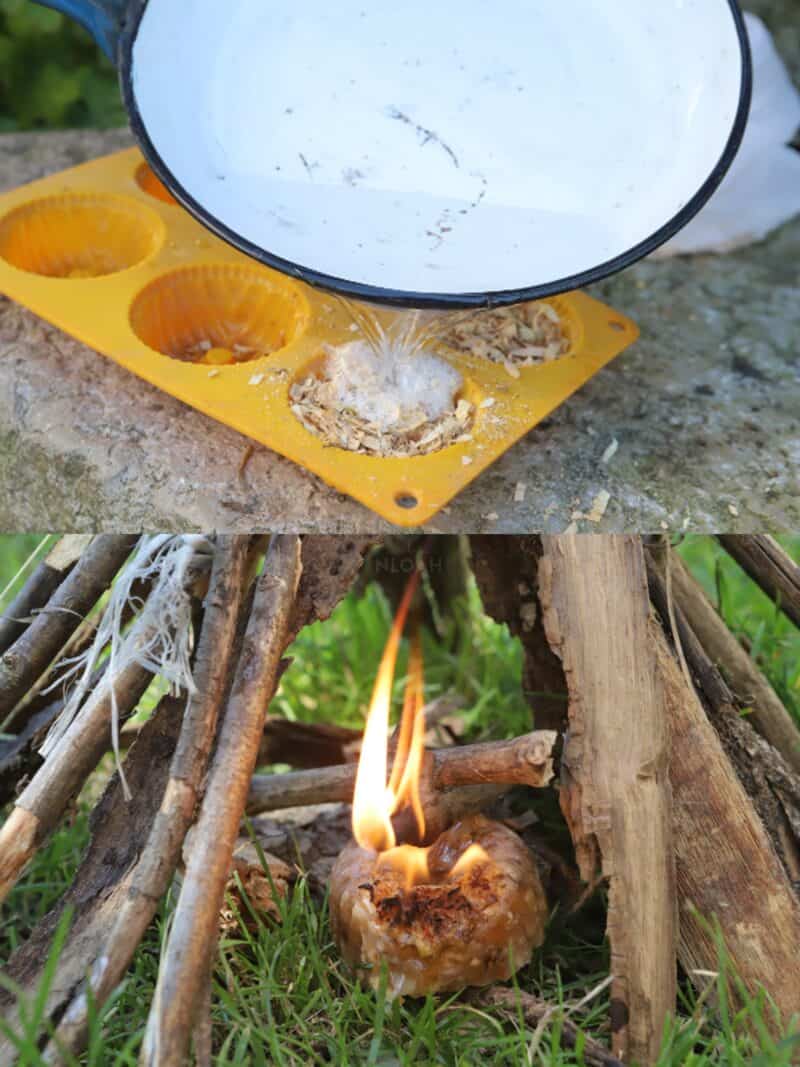
I’m sure there are more uses for sawdust and we often find ideas out by accident. One year my kids used some sawdust in a nativity scene as snow and it worked very well.
Compost Pile
There are many components to a compost pile. Sawdust decomposes very slowly so it will work well to help aerate the soil and mix in with heavier soils to help balance out the green materials in the compost pile.
It will take about a year to change sawdust into compost. You’ll want to turn it frequently in order to help it decompose more quickly.
It will help to nourish the soil and increase the organic matter which will make it ideal for amending the garden soil next year.
Just remember to balance out how much you’re putting into the compost pile. You’ll want to add some slow release organic fertilizer if you’re in a hurry for your compost pile to decompose.
Although it can take several years for sawdust to break down, it will help to add some nutrients to the compost and it will aid in the decomposition of some of the other components.
Just remember to turn your sawdust in the compost pile often and make sure that you’re adding a good balance of materials to the compost pile.
Interesting Facts And Uses For Sawdust On The Homestead
Here are some other interesting facts and uses for sawdust on the homestead. It’s amazing how many uses you can find once you put your mind to it.
We asked around and found some clever unique uses for sawdust not only on the homestead, but in other places as well.
Restaurant Use
Have you ever been in a barbeque restaurant or bar and grill that has sawdust on the floor? Did you wonder why they used sawdust on the floor?
In addition to making it look old-fashioned, it also aids in absorbing liquids (alcohol, water, moisture coming in on shoes and the like). It helps them to keep things cleaner, not need to mop up every night and it lends a certain ambiance to the entire décor.
All they have to do is sweep the sawdust up nightly and then spread more on the floor the next day. It absorbs everything and it actually cuts down on dust.
Food Additive
Did you know that there are many foods that contain sawdust? It’s a well-known fact that there are many foods that you eat on a daily basis that contain sawdust as an additive.
Sawdust is used as a binder, filler, and to add fiber to many foods that you eat on a daily basis. Here is a brief list of foods that contain sawdust. How many of them have you eaten recently?
Composting Toilets/Port-A-Potty
There are many folks who choose to run their homesteads off the grid. Composting toilets require something as a substrate to absorb liquids and make them work properly.
Sawdust is an ideal substrate for composting toilets and it’s very affordable over other methods such as peat moss for composting toilets.
In fact, in many cases, it’s actually free so you can simply keep a few buckets in the outhouse or bathroom area for your composting toilet and be rid of odors for good.
In an emergency situation, you can also use sawdust and an old 5-gallon bucket to create your own port-a-potty.
Simply line it with a garbage bag, add in some sawdust as a substrate material, and then take an old pool noodle and cut it to fit the top of the bucket for a “seat”.
We had to do this for the little ones when they were younger and helping in the barn. It worked and we simply put it in an unused stall and called it the “barn potty”.
Ice Storage
It’s not uncommon for those who live off the grid to store ice. Sawdust is ideal for helping to preserve those ice blocks.
While some homesteaders use straw or hay to store their ice blocks, others will use sawdust. Ice is stored in a cold cellar or ice house, and sawdust is ideal to help keep the ice insulated and cold.
Where To Get Sawdust
Not everyone has a ready source of sawdust. While many homesteads use wood heat they may not always have sawdust around from cutting that wood due to the location that they go to for wood cutting.
If you don’t have a ready supply of sawdust there are several ways you can go about finding a ready supply for little to nothing.
- Local sawmill.
- Local woodworkers.
- Other homesteaders who cut wood on site and have an excess.
- City/county tree cutters/trimmers.
If you see someone cutting or trimming trees while you’re out running errands for the homestead you can always stop and ask them if they need a place to dump off the wood chips or the sawdust.
Offer your homestead up as a location and many will take you up on it if it’s not too far out of their way to deliver the sawdust or wood chips.
Cautions!
When using sawdust in the garden and in the compost pile keep in mind that it can rob the soil of nitrogen.
Using “green” or raw sawdust can lead to a nitrogen deficiency so always allow the sawdust to “cure” for at least a year in the compost before you apply it to the garden.
Turn it frequently to ensure that it’s all decomposing with the rest of the materials in your garden compost.
Use a slow-release organic fertilizer if you’re in a hurry and need to cure your sawdust in the compost pile faster.
Always start with small applications to see how your plants will react when you’re using sawdust in and around plants.
That way if your plants have a reaction (see yellowing plants below) you can rake it out easier without worry of plant damage.
Plants that turn light yellow may be suffering from a nitrogen deficiency. Use a side dressing of compost like alfalfa meal, manure, or blood meal if this happens.
Pine sawdust is a “brown addition” and may be better used as a pine sachet that you make and place in a closet or drawer.
Simply sew some pretty fabric into a little pouch and stuff it with sawdust. Stitch the end into place and you can use it to scent a drawer, closet, car, etc.
Always make sure that the wood that is used for sawdust hasn’t been treated with chemicals. You don’t want chemicals leeching into the soil or your compost pile.
If you’re receiving your sawdust from a local sawmill or store, ask them if the wood used in making the sawdust has been treated with chemicals or pesticides before you cart it off to your homestead.
Don’t be afraid to ask if there are chemicals on the sawdust if you’re sourcing your sawdust from somewhere else. When in doubt, don’t use it.
Many regions are prone to termites and carpenter ants. If you’re in such a region make sure that you keep the sawdust pile away from outbuildings, barns, and the house itself.
If you’re cutting your own trees or know the source you can avoid the chemicals.
Sawdust is made up of finely ground wood and should be allowed to properly dry out. Avoid storing large amounts that haven’t dried in an enclosed area or you could be risking spontaneous combustion.
Sawdust comes in different sized particles. Avoid fine particles that may be inhaled by pets and people on the homestead. You don’t want breathing issues on the homestead.
Be aware that walnut sawdust has an herbicide that may kill your plants. Use it for killing weeds on a garden path but avoid using it in and around plants that you want to keep.
There are many great uses for sawdust on the homestead. These are but a few of our favorites. Each homestead is different and what works well on one homestead may not work at all on another.
Keep in mind that the type of wood used for the sawdust that you use may also play an important roll in how you choose to use your sawdust on your homestead.
Cherry and apple woods make ideal wood chips for smokers and will impart a delicate aroma and flavor sensation to the foods that are being prepared. While pine and cedar may be more aromatic when used in fire starters and firebricks.
Other types of wood may lend themselves more to other uses so take a few moments to smell the sawdust that you’re about to use and consider how you’re going to use it.
You’ll be amazed at how different types of wood lend themselves differently to your sawdust uses.
Part of homesteading is learning how to make do with what you have. We’ve learned a variety of uses for sawdust and more on our homestead.
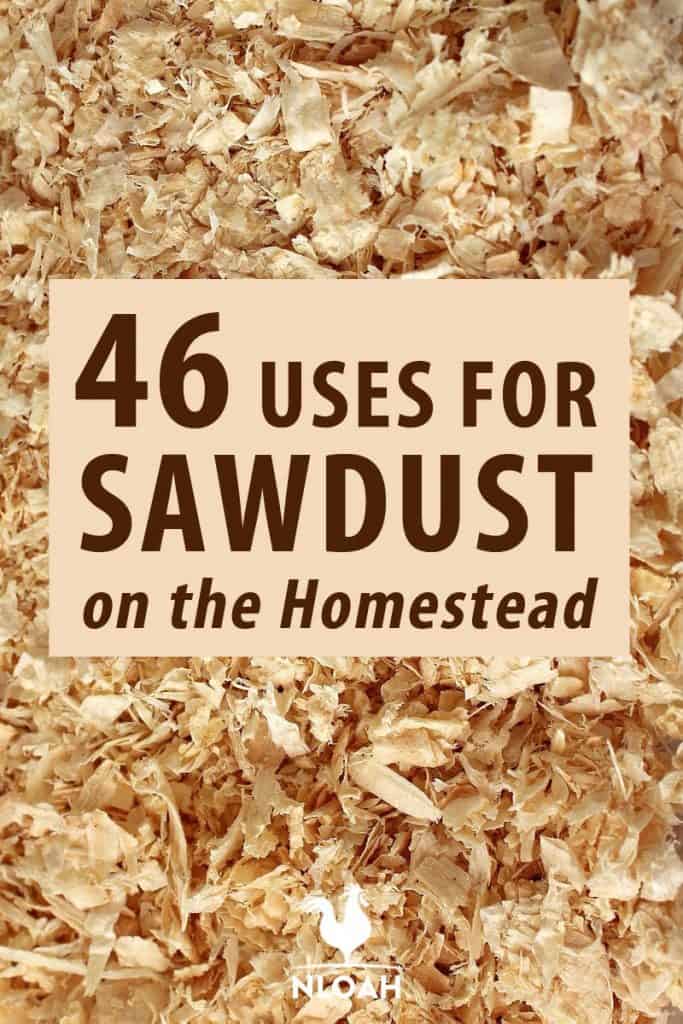

Hi, I’m Linda. I’m a mom, grandmother, homesteader. I love simple living and enjoy my life on a homestead where I garden, raise a variety of animals and strive for a life more like my grandparents lived.
My goal is to enrich life by living it as simply as possible and focusing on the way my grandparents did things. Life is so much more fun when it’s lived simply.

How do you dry out the saw dust to put them in the fabric bags?
Can saw dust be used on a dance floor instead of dance floor wax?
If using for animal bedding, do not use walnut sawdust. In equines, this can have severe consequences (laminitis). No idea if anything similar results from walnut bedding for other animals.
I am moving out to my homestead later this spring and I am so excited that I have already lined up my source of sawdust.
Where is the link to see what foods contain sawdust?